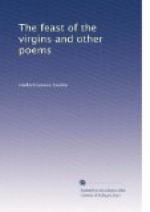[3] Pronounced Wah-zee-yah—the god of the North, or Winter. A fabled spirit who dwells in the frozen North, in a great teepee of ice and snow. From his mouth and nostrils he blows the cold blasts of winter. He and I-to-ka-ga Wi cas-ta—the spirit or god of the South (literally the “South Man”) are inveterate enemies, and always on the war-path against each other. In winter Wa-zi-ya advances southward and drives I-to-ka-ga Wi-cas-ta before him to the Summer-Islands. But in spring the god of the South having renewed his youth and strength in the “Happy Hunting Grounds,” is able to drive Wa-zi-ya back again to his icy wigwam in the North. Some Dakotas say that the numerous granite boulders scattered over the prairies of Minnesota and Dakota, were hurled in battle by Wa-zi-ya from his home in the North at I-to-ka-ga Wi-cas-ta. The Wa-zi-ya of the Dakotas is substantially the same as “Ka be-bon-ik-ka”—the “Winter-maker” of the Ojibways.
[4] Mendota—(meeting of the waters) at the confluence of the Mississippi and Minnesota rivers. The true Dakota word is Mdo-te—applied to the mouth of a river flowing into another, also to the outlet of a lake.
[5] Pronounced Wee-wah-stay; literally—a beautiful virgin or woman.
[6] Cetan-wa-ka-wa-mani—“He who shoots pigeon-hawks walking”—was the full Dakota name of the grandfather of the celebrated “Little Crow” (Ta-o-ya-te-du-ta—His Red People) who led his warriors in the terrible outbreak in Minnesota in 1862-3. The Chippeways called the grandfather Ka-ka-ge—crow or raven—from his war-badge, a crow-skin; and hence the French traders and courriers du bois called him “Petit Corbeau”—Little Crow. This sobriquet, of which he was proud, descended to his son, Wakinyan Tanka—Big Thunder, who succeeded him as chief; and from Big Thunder to his son Ta-o-ya-te-du-ta, who became chief on the death of Wakinyan Tanka. These several “Little Crows” were successively Chiefs of the Light-foot, or Kapoza band of Dakotas. Kapoza, the principal village of this band, was originally located on the east bank of the Mississippi near the site of the city of St. Paul. Col. Minn. Hist. Soc., 1864, p. 29. It was in later years moved to the west bank. The grandfather whom I, for short, call Wakawa, died the death of a brave in battle against the Ojibways (commonly called Chippeways)—the hereditary enemies of the Dakotas. Wakinyan Tanka—Big Thunder, was killed by the accidental discharge of his own gun. They were both buried with their kindred near the “Wakan Teepee,” the sacred Cave—(Carver’s Cave). Ta-o-ya-te-du-ta, the last of the Little Crows, was killed July 3, 1863, during the outbreak, near Hutchinson, Minnesota, by the Lampsons—father and son, and his bones were duly “done up” for the Historical Society of Minnesota. See Heard’s Hist. Sioux War, and Neill’s Hist. Minnesota, Third Edition.




